The parenthood of any invention of consequence is almost never cut and dried. The natural tendency to want a simple story that’s easy to tell — Edison invented the light bulb, Bell invented the telephone — often belies the more complex tale: that most inventions have uncertain origins, and their back stories are often far more interesting as a result.
Inventing is a rough business. It is said that a patent is just a license to get sued, and it’s true that the determination of priority of invention often falls to the courts. Such battles often pit the little guy against a corporate behemoth, the latter with buckets of money to spend in making the former’s life miserable for months or years. The odds are rarely in the favor of the little guy, but in few cases was the deck so stacked against someone as it was for a young man barely out of high school, Philo Farnsworth, when he went up against one of the largest companies in the United States to settle a simple but critical question: who invented television?
Furrows of Electrons
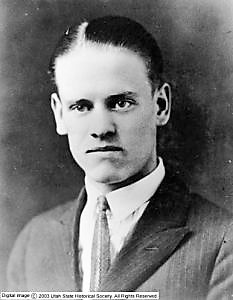
Many great tales of American achievement start with the hero’s birth in a log cabin, and Philo Taylor Farnsworth’s story starts just this way. His family lived in a cabin in Utah when he was born in 1906. They would live in that remote location until moving to Rigby, Idaho when Philo was 12. The Farnsworth family had never had electricity in their Utah cabin, and Philo was excited by the discovery that their new ranch had a generator. He took to electricity quickly, rewiring motors and electrifying the farm in his spare time, and devouring all the reading material he could find on the subject. Electricity just made sense to Philo.
From his reading, he knew of the ideas floating about for television, all of which relied on cumbersome systems using mechanical devices to optically scan and reproduce a scene. Philo thought there must be a better way, and as he reported later, the furrows created as he plowed a field on the ranch gave him the idea for building up an image line by line. Philo realized that this would be the key to creating an electronic television system.
Whether this actually happened, and how the 13-year-old Philo translated that inspiration into an all-electronic television system, is unclear. What is clear is that in 1922, during the spring semester of his freshman year at Rigby High School, Philo approached his chemistry teacher to discuss some ideas he had regarding a vacuum tube to capture moving images. Philo filled the blackboards with his sketches and ideas for an “image dissector,” a tube with a screen covered with cesium oxide opposite an electron gun. Light falling on the screen would cause the cesium oxide to emit photoelectrons, forming an “electron image” on the screen. Deflection coils would scan the screen with electrons from the gun at the back of the tube. Areas with more photoelectrons would reflect the incident cathode rays back to a detector, providing a signal that could be amplified.
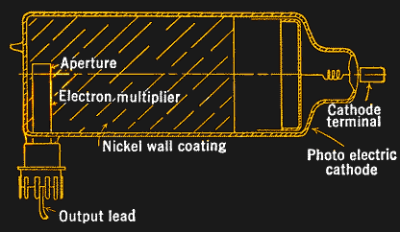
Soon after discussing his ideas with his teacher, the Farnsworth family moved back to Utah. Philo finished high school and attended Brigham Young University but never completed a degree. By 1926 he had convinced a pair of what we’d now call “angel investors” to plow $6,000 into his image dissector idea, and he moved to California to chase his dream. Having already done some development on the tube at BYU, he was ready within a few months to apply for a patent, and on January 7, 1927 he submitted an application simply entitled “Television System.”
Reading Farnsworth’s 1927 patent application, it’s hard to believe that it was written by someone who hadn’t even encountered electricity for the first 12 years of his life. And yet a mere nine years later, young Philo had not only mastered the basics of electricity, he had progressed far enough to submit a patent application that described a complete television transmission system, from image capture to eventual reproduction on a receiver. What some people would take a lifetime to accomplish, Philo had managed before his 22nd birthday.
Enemies at the Gates
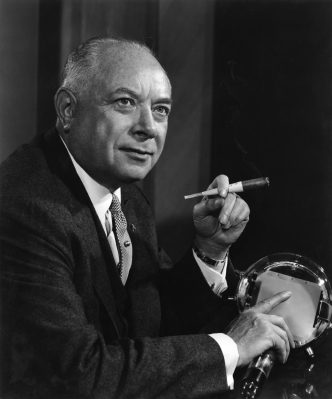
By September of 1927, Farnsworth has successfully used his image dissector to transmit the world’s first electronic television signal — a single thin line scratched into a smoked glass slide. Progress was rapid from that point. A demonstration for the press was held in 1928, and in 1929 the first image of a human face, that of Farnsworth’s wife Pem, was transmitted.
Farnsworth wasn’t the only one with ideas about how to make electronic television a reality. Vladimir Zworykin had been working on his iconoscope since at least 1923, and while his design for a camera tube was superior to Farnsworth’s, which required impractically high light levels to deliver a usable picture, the iconoscope suffered from one major flaw: it didn’t work. Despite years of effort, Zworkykin had never been able to produce a tube that worked well enough to show his employers at Westinghouse. He did, however, have a patent for a television system built around this tube, issued in 1923.
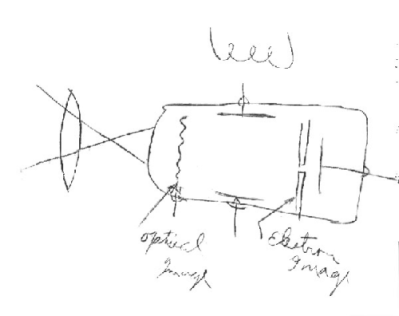
Zworykin was recruited to radio giant RCA in 1930 by broadcasting head David Sarnoff. Sarnoff saw that television was going to be big and couldn’t afford to have RCA miss out. To hedge his bets, or perhaps to stifle the competition, Sarnoff offered Farnsworth $100,000 for his image dissector patent. Farnsworth stubbornly refused this princely sum, setting off a patent war between the boy inventor and one of the largest corporations in the country. RCA sued Farnsworth, claiming that Zworykin’s 1923 patent had priority even though he had never made a working version of his iconoscope, or “reduced to practice” in patent law parlance. RCA won the first round, as well as a subsequent appeal, but in 1934 a judge sided with Farnsworth, partly on the strength of handwritten notes made by Justin Tolman, Philo’s high school chemistry teacher. Tolman had sketched out Philo’s blackboard drawings at Rigby High all those years before, providing support for Farnsworth’s claim that he thought up the idea of electronic television at least a year before Zworykin’s patent was issued.
A Phyrric Victory
Farnsworth won the war, but the market would decide the real victor. The iconoscope was the superior tube for broadcast television, and once it was perfected it became the standard around which the television industry was built. It also effectively stranded the royalty payments that would have been due from RCA had Farnsworth’s tube taken off. The image dissector didn’t go away completely, though; given their need for abundant light, Farnsworth tubes were used for remote monitoring of furnaces and boilers, as well as arc welding and similar processes.
Apart from the image dissector, Farnsworth was a prolific inventor. He racked up hundreds of patents for everything from radar to telescopes to a baby incubator. He was also famous for the Farnsworth-Hirsch Fusor, a nuclear fusion reactor used commercially to this day to produce neutrons and even by hobbyists to perform desktop fusion.
Sadly, Farnsworth died young, at 64, after a bout of pneumonia brought on by the stress of a failed business venture that bankrupted him. It’s a sad end for a life in which he accomplished so much, but his legacy will always be tied to that teenage dream of sending moving pictures through the air and those chalkboard drawings at Rigby High.

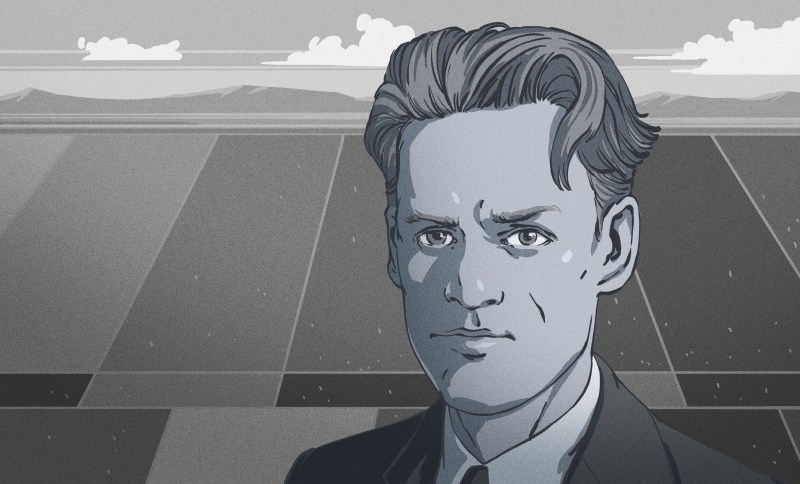














“The parenthood of any invention of consequence is almost never cut and dried.”
Even more true as science and technology has become more complicated.
Is it really more complicated these days… I highly doubt that.
You could say that all easy things have already been invented, but that’s nonsense.
Because things only seem simple when they are already there, when you know how something works it suddenly isn’t as complicated any more.
The problem with new inventions or discoveries is that it has to be something that doesn’t exist yet.. or at least not in that form. Because most inventions are adaptations of ideas of others. Failed inventions polished to a new idea that after a few iterations does work and does something wonderful.
You could argue that the basic laws of science are all figured out, but I doubt that, there certainly much more that we don’t know. Quirks in the laws of nature that we aren’t aware of because we don’t observe properly of at the wrong scale. Not knowing about these things doesn’t mean that they aren’t there to be discovered
We live in a wonderful time and age of technology, information is just a few mouse clicks away, I would dare to say that these days we are discovering more and more and at a faster pace then ever before. And by sharing our knowledge using the internet we inspire others to do the same. A chain reaction of ideas fueling technological progress.
Okay I got a bit carried away there, but I think the message is clear. It isn’t any more complicated then it was 100 years ago, it’s just different.
I think the big difference is it is very difficult to be a polymath because the cutting edge of science is now several life’s work. Only those that can combine innate ability in a subject with access to a well targeted and focussed digestion of several lifetimes of work can gain the understanding, and even then in ever wider collaborative groups; it is visible that the Nobel prize is struggling as it only awards to up to 3 collaborators, which was fine in the fifties, just about manageable in the eighties and downright insufficient now. Good higher education is not affordable to many people, and non-university trained inventors struggle to make inrodes into modern technology like they used to be able to (they were the core inventing group!). Then add the psychological stereotypes that people willing to challenge prior conceptions enough to be strong inventors may struggle to quickly accept prior work and move on – as required during university training. And then the topic of this article is truer today than ever, when you have no way of reading all the relevant ip in any subject area, and the bar for obtaining a patent is measured not by inventiveness but how deep your pockets are (e.g. Nestle have a patent for sealing nespresso capsules with an o ring – the go to most basic seal in the designer’s toolbox – despite the requirement to be both novel (no one has done it before) and inventive (it would not be obvious to someone skilled in the art)) the cost of getting a patent granted internationally is getting on for $100k, and that’s before you have all the risk of whether your commercial enterprise to gain money off your invention has legs. Given you need reliable protection more than one patent is likely needed, you need the money to prosecute your patent against a company that infringes, and you need to spend a lot in front end development, commercial assessment etc. to know the business case stacks up and even then have a high infant mortality of startups, you probably need to be a millionaire to go from shed to success with a technical invention. Bear in mind it is still possible to create exciting product propositions by combining known technology, which is what will come to mind with almost any start up.
success has many fathers, failure is an orphan
I recall seeing this postage stamp
https://d1ca4yhhe0xc0x.cloudfront.net/blog/graphics/farnsworth-stamp.gif
Notes from your high school teacher won’t save you anymore, at least in the USA. Since 2013, the USPTO uses first-to-file to establish priority as opposed to the earlier first-to-invent system. A modern Farsnworth might do well to learn about provisional patents.
So that bastard, Sarnoff, killed both Farnsworth and Edwin Armstrong with his patent wars…
I sometimes wonder if Sarnoff was targeted to be killed when he starting wanting to implement and promoted in the late 50’s distributed nuclear power stations in buildings and if I understand correctly… homes through RCA by 1990 (The Canadian Home: From Cave to Electronic Cocoon, pg.118)… not only with their atomic battery envisioned to be implemented in most places by 1980 (Belief-based Energy Technology Development in the United States: A Comparative Study of Nuclear Power and Synthetic Fuel Policies, pg.29).
And I thought we’d have small scale nuclear power plants by now also (I’d like to see external combustion personally versus thermoelectric or thermosteam or whatever you call the later modern using water and the phase change from liquid to vapor). Doesn’t look like yet based on these 2008 articles: https://www.theguardian.com/environment/2008/nov/09/miniature-nuclear-reactors-los-alamos
https://www.wired.com/2007/12/toshibas-home-n/
We’ll see how that pans out:
https://en.wikipedia.org/wiki/Gen4_Energy
https://lockheedmartin.com/en-us/products/compact-fusion.html
I still hope that LFTR will be reconsidered.
https://en.wikipedia.org/wiki/Liquid_fluoride_thorium_reactor
Yeah, I have to read into the thorium reactors more (thanks for the link) as I last recall India leading the latest way… though I like the thinking especially in regards to using flourine which is one of those chemicals I don’t really want leaking out everywhere and is better off either covalently bonded or sealed and contained really well for systems operations kind of like improved refrigeration systems (that can be sealed even better yet).
wernstrom!
I give your reference the worst grade imaginable, an A minus… minus!
Didn’t this guy invent the “Fing-longer”?
And the Farnsworth test for color blindness
*Looks at color blindness test*
Where is he damn it?!
True story, I might be related to Philo Taylor Farnsworth. There is –or, rather, mostly-was, she’s sadly slowly dying of Alzheimer’s right now– a rather dedicated genealogical researcher in my family, and she unearthed an ancestor of mine named Philo Taylor (there’s documentation of this, somewhere)… no Farnsworth on the end of that, but logically speaking, there’s a fairly high probability that the name is not random coincidence… especially because the Philo Taylor in my family was only a generation or so after Philo Taylor Farnsworth himself…
So, hey, kinda cool, maybe.
Mom has recently taken up the work that the relative of mine left behind when she had to stop… so maybe I’ll know more in a year or two. Who knows?
I’ve driven by Farnsworth’s house in Fort Wayne, IN many times. My father was an engineer at the old Pontiac St. ITT facility, where Farnsworth’s lab was, when I was a kid. Unfortunately, that was all after he passed away :(
https://www.geni.com/family-tree/index/6000000010888270283
Funny thing — the link to Farnsworth’s patent actually goes to goes to Zworykin’s patent. Freudian patent slip?
Edwin Armstrong got screwed pretty badly, too. The inventor of FM and the Superhetrodyne receiver, he spent most of his life fighting the big guys in court. He ended up jumping to his death. A few months later, his case was settled in his favor for $1 million…. https://en.wikipedia.org/wiki/Edwin_Howard_Armstrong
There’s a great book on this tragic conflict called “Empire of the Air”, by Tom Lewis. Ken Burns made it into a TV show and a David Ossman of Firesign Theatre made it into a radio show. All excellent. https://en.wikipedia.org/wiki/Empire_of_the_Air:_The_Men_Who_Made_Radio
Yep. “Empire of the Air” is great.
Armstong did his development in a laboratory in the basement of Philosophy Hall at Columbia University.
http://www.columbia.edu/cu/alumni/Magazine/Spring2002/Armstrong.html
Wow, that is sad!
The imaging tubes used in pre-CCD cameras are actually Farnsworth’s image dissector design with a photo-multiplier stage added. RCA only threw in the towel on the patent fight after ‘locking away’ a team of engineers who were supposed to make Zworykin’s design work. What they built was essentially identical to Farnsworth’s because it was the only way that *could* work. farnovision.com
I’m surprised no one mentioned the communication devices from Warehouse 13 with his name…????????
I have 3 words for all of you.
John
Logie
Baird
He’s one of the people who invented what this article refers to as “cumbersome systems using mechanical devices to optically scan and reproduce a scene”.
I recall him from a BBC/PBS program that always started with black and white cartoons talking in funny English sounds with clips during the show of the subjects doing the same. I can’t remember what the show is called now!
Looks like all my references may be private youtube videos now or deleted regarding the example I wanted to share. Darn.
I did find this interesting huge old school camera basically used to broadcast the first TV image: https://www.youtube.com/watch?v=2WiV0FIFpHE
That’s not the funny English sounding show with the two hosts, where one is the engineer and the other is the presenter typically. The gentlemen almost looks like James Burke though smaller I think and the engineer is a little heavier with a trimmed beard I think typically. Neat show though… strange I can’t find as was really neat in presentation and examples. I can’t remember the name either.
Found it in my YouTube history… man… I can’t believe I didn’t save or like since the series is awesome and I remember watching as a boy on PBS: https://www.youtube.com/watch?v=uD8d1r52lWg
The Secret Life of Machines is the series.
Strange how Philo Farnsworth isn’t mentioned… only the EMI system based on “Zworykin’s”. Fun with concurrent international technological systems invention, development and implementation.
Ministry of Truth
Nipkow disc based television (1928 advertising):
https://upload.wikimedia.org/wikipedia/commons/thumb/c/c4/Science_and_Invention_Television_1928.jpg/1024px-Science_and_Invention_Television_1928.jpg
https://www.aoc.gov/art/national-statuary-hall-collection/philo-t-farnsworth
The $100,000 1930 dollars that Farnsworth turned down for his patent inflates to almost $1.5 million in 2018.
It’s Pyrrhic – not Phyrric https://en.wikipedia.org/wiki/Pyrrhic_victory